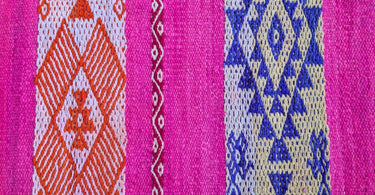Introduction
In the Andes, weaving has never been just a craft, it is a way of telling stories.
Every geometric form and repeated pattern carries meaning that has traveled through generations. For centuries, artisans have woven their identity, their worldview, and their connection to nature into fabric.
At Lo Mio, we honor that legacy by transforming ancestral patterns into pieces that bring cultural depth and authenticity into modern homes.
Textiles as a Visual Language
Anthropologist William J. Conklin (2000) described Andean textiles as “structures that carry meaning.”
The organization of the design, its rhythm, repetition, and geometry is a form of visual communication.
Patterns are not simply decoration; they are messages.
Diagonal lines may represent rivers or paths, continuous repetitions echo the harmony of the cosmos, and the empty spaces embody silence or respect for the unseen.
To those who know how to read them, these fabrics are not just seen, they are understood.
Patterns that Tell Stories
Each motif carries a unique symbolism, varying from one community to another.
Some of the most traditional patterns include:
Chakana (Andean cross)
The core symbol of Andean cosmology, representing the three worlds: celestial, earthly, and spiritual, and the union among them.
Diamond shapes
Linked to vision, the eye that observes the world, and the connection between human and divine.
Zigzags
Inspired by serpents, rivers, or mountain paths, sacred symbols of movement, transformation, and wisdom.
Repeated triangles
Representing mountains or apus, the spiritual guardians of the Andes.
Stepped forms
Recalling agricultural terraces and the balance achieved through collective work.
Every pattern is intentional.
Weaving, in this sense, becomes a form of language, one that speaks of territory, memory, and harmony.
Order, symmetry and harmony
Andean textiles reflect a philosophy of balance.
Nothing in the design is random. Each shape is placed in rhythm, the borders mirror one another, and the center marks the axis, the point of connection between the human and the natural worlds.
This visual symmetry mirrors the Andean worldview, where duality and complementarity sustain life.
Every woven composition is more than art; it is a meditation on the relationship between people, community, and nature.
A Living Source of Inspiration
In communities such as Chinchero and Patabamba (Cusco), weavers continue to reinterpret ancestral motifs, blending traditional structure with contemporary creativity.
What once identified a family or region now inspires one-of-a-kind pieces that preserve their symbolic roots.
At Lo Mio, these patterns inspire modern design.
Each rug and textile we create pays homage to this ancient visual language, reimagined with respect, authenticity, and intention.
Every handmade piece continues a dialogue between past and present, between craftsmanship and culture.
Conclusion
Andean patterns are a woven language, one that holds centuries of wisdom within its threads.
Behind every figure lies a story of balance, identity, and reverence for the natural world.
When an artisan textile enters a home, it carries more than beauty; it carries meaning.
A reminder that true artistry is not imposed, it is woven with purpose.

